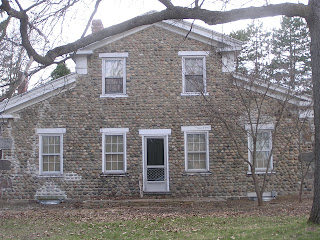The movement of ice age glaciers are responsible for the large concentrations of coursed cobblestone homes found in Southeastern Michigan and Upstate New York. this unusual building technique has its origins in Upstate New York. Some scholars speculate that after the Erie Canal was finished in 1825, unemployed canal masons built dozens of these homes in close proximity paralleling the canal from Rochester to Buffalo. Others navigated the canal and moved westward and continued the trend. Southeast Michigan has an abundance of homes that employ this unique folk art construction technique. Former Eastern Michigan University graduate student Joan Boddie documented twelve remaining homes in Washtenaw County, many of whose original owners came from Upstate New York.
 |
| Hen-and-chick configuration |
Stone sizes ranging two to six or more inches are laid in straight courses or diagonally creating a herringbone pattern. Stone colors can be a variety of colors from brown to pink or yellow and gray, the later two signifying glacial activity. In preparation for building, sizing parties used screening techniques to high-grade stones for consistent courses.
Three types of wall construction are generally found. The earliest is a rubble wall where an inside random stone and outside coursed wall are erected simultaneously. Second was a modified version using longer anchor stones periodically extending into the central core. The later technique, most susceptible to weather damage, assembled interior walls first and added a coursed cobblestone veneer wall later.
Likely originating due to economy, aesthetics and the availability of unemployed canal masons, coursed cobblestone homes had a limited construction period from 1825 to 1860. The construction style made economical use of the abundant stones drudged up in newly plowed fields. Aesthetically pleasing the method was time consuming due to the stone sizing and ensuring level and uniform coursing. this may explain why large numbers of homes have only coursed front facades and sidewalls, where the other less visible sides are random fieldstone.
Some debate surrounds the demise of this short lived folk art building technique. One is that the masons never instructed a new generation, but studies reveal that few masons built more than three coursed cobblestone houses and mortar recipes were freely published in farmer's journals. It is more likely that as railroads and powered sawmills reduced the cost of other standard building materials, Americans embracing industrialization chose the less time consuming construction methods.
 |
| Cobblestone Farm |
